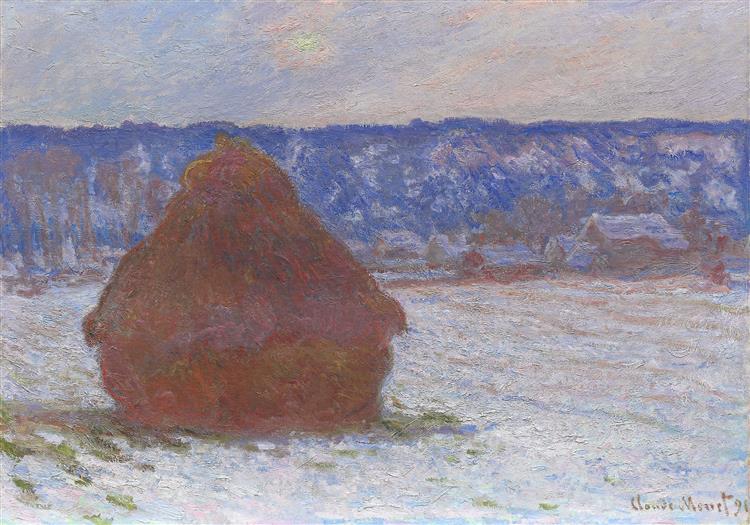Description
Claude Monet's 1891 work "Stack of Wheat (Snow Effect - Cloudy Day)" is a magnificent example of the artist's innovative approach to light and color, as well as his signature technique of loose brushwork. Monet, a leader of the Impressionist movement, was dedicated to capturing in his work the immediacy of visual sensations and the emotions that the landscape generates in the viewer. This painting is part of his series of stacks of wheat, a recurring theme in his artistic production that illustrates the agricultural cycle of the Normandy area, where he was originally from.
The work depicts a stack of hay in a landscape covered by a blanket of snow, which, through its pictorial treatment, suggests the coldness of a cloudy day. The composition focuses on the stack of wheat, which appears as the main, almost sculptural element on the canvas. The mass of hay, dominated by a palette that oscillates between brown, grey and white tones, rises majestically in the centre of the work, capturing the essence of rural life and agricultural work.
The atmosphere of the painting is defined by a leaden, grey sky, a feature that echoes the climatic phenomenon that Monet sought to portray. The vibrant, loose brushstrokes strengthen the sense of an ephemeral moment, where dim light plays a crucial role in the interplay with form and colour. The snow, with its almost unreal luminosity, enhances the contours of the pile, while the deep shadows add a sense of depth and volume, thus achieving a harmonious balance between the real and the emotive.
In this work, there are no human characters present; the focus is solely on nature and its representation. This absence translates into a deep sense of introspection, inviting the viewer to contemplate the beauty of the rural environment and the fragility of life in nature. The representation of the landscape is closely linked to the impressionist philosophy, which sought to capture not only visual reality, but also the artist's emotional response to his environment.
Monet repeatedly worked on the theme of wheat stacks, varying the atmospheric conditions and light in each of his depictions. This particular work, with its snow effect, stands out in its ability to evoke winter sensations, rich in nuances of light that transform the landscape into an almost tangible spectacle. Snow, which could symbolize the stillness and silence of winter, becomes a means of exploring the interaction between light and forms in space.
It is interesting to consider that Monet painted this series during a time of great artistic experimentation, when he was moving away from more academic representations and venturing towards an approach that prioritized visual perception over optical precision. "Stack of Wheat (Snow Effect - Cloudy Day)" is, in this sense, a milestone in his artistic evolution, where the plein air technique - painting outdoors - allowed Monet to capture the fleeting nature of the moment and the passage of time. Such an approach not only marked a change in his work, but also profoundly influenced the development of modern art.
In conclusion, this work by Monet is a visual dialogue between light, color and form, where nature is established as the protagonist in an almost sacred stillness. Through the "Stack of Wheat (Snow Effect - Cloudy Day)", the viewer not only witnesses a beautiful representation of the winter landscape, but is also invited to experience the emotional connection between human beings and nature, a recurring theme in Monet's vast corpus.
KUADROS ©, a famous painting on your wall.
Hand-made oil painting reproductions, with the quality of professional artists and the distinctive seal of KUADROS ©.
Painting reproduction service with satisfaction guarantee. If you are not completely satisfied with the replica of your painting, we will refund 100% of your money.

